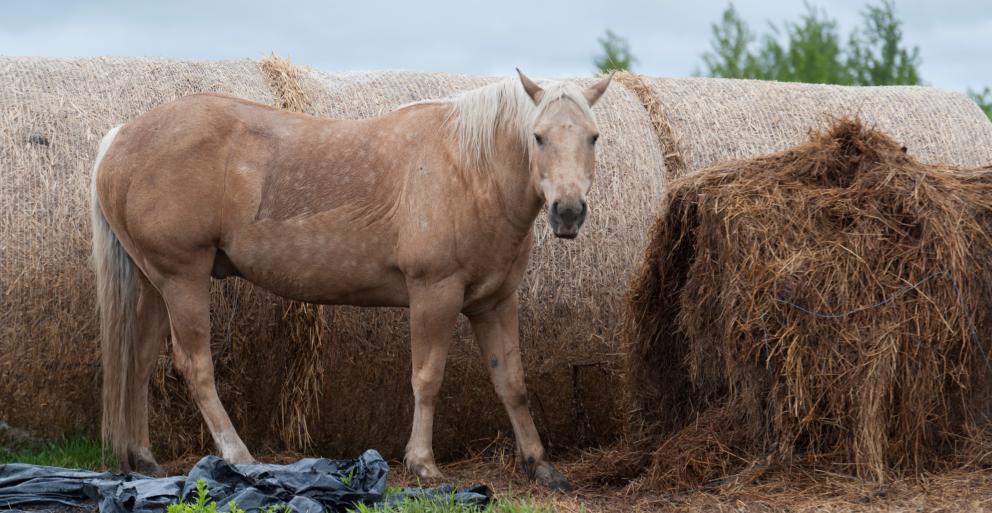You are here
Recurrent Airway Obstruction (RAO) in Horses - Heaves

What is heaves?
Heaves is a common chronic respiratory disease triggered by inhaled particles from hay, straw, and dust. Airways in the lungs narrow and become obstructed for several reasons: from swelling due to inflammation, thickening of the tissues of the airways over time, constriction of the muscles around the airways, and mucus in the airways. Heaves is similar to human asthma.
How does a horse get heaves?
Affected horses are sensitive to allergens in hay, straw, and dust so heaves is most commonly seen in stabled horses. Generally, heaves is seen in older horses because it takes time for airway changes to develop. Some horses can develop a similar condition in the pasture from inhaling mold spores.
What are the symptoms of heaves?
Affected horses have a cough, occasional white nasal discharge, and have laboured breathing even at rest. Flared nostrils are seen in acute episodes. The symptoms commonly worsen when exposed to the allergen. The cough is worse when the horse is eating or exercising. Because the horse is working harder to breathe, over time the abdominal muscles become over-developed creating what is called a ‘heave line’ visible along the horse’s flank.
Is there a test for heaves?
In severe cases, the diagnosis can be made by your veterinarian taking the medical history of the horse and performing a physical examination. Additional testing may be needed to rule out other diseases particularly in horses that have mild disease or that fail to respond to the prescribed treatment. The most commonly performed laboratory test is bronchoalveolar lavage to examine cellular change in the airways.
Do we see heaves in Alberta?
Yes, heaves is diagnosed across North America. Horses that are predisposed to heaves can develop clinical signs within 6 to 8 hours of being moved from pasture to stable and being fed hay. Your veterinarian can prescribe pharmaceuticals to relieve airway obstruction and reduce inflammation in the lungs. Treatment may involve the use of aerosol medication, and there are several inhalers adapted for horses i.e. AeroMask and Equine Haler.
Some bloodlines of horses seem to be more susceptible to developing heaves. (Effects of genetic and environmental factors on chronic lower airway disease in horses, Journal of Veterinary Internal Medicine, 21:1, 149 – 156, 2007)
How do I protect my horse from developing heaves or having heaves worsen?
1. Protect your horse by reducing contact with allergens in the environment. Horses with heaves are best housed on pasture eating grass and pelleted feed. Hay cubes or silage are preferable to regular hay, which contains many allergens. If those aren’t available, soak your horse’s hay in water for about 5 minutes before feeding to reduce the dust and spores.
Other ways to reduce exposure to dust:
- Avoid storing hay over horses’ heads
- Avoid large round bales
- Move the horse to a stall in the barn where there is the least dust
- Barns with an indoor horse arena will be dustier and problematic for affected horses
- Assess barn ventilation to help dust removal and increase air circulation
- Avoid constant sweeping, which keeps dust particles circulating. Remove horses from the barn when sweeping is happening.
- Wood shavings may be better than straw for bedding i.e. less dusty
- When housed outdoors, keep the horse away from dusty roads or paddocks
2. Prevent viral respiratory infections, which will compound respiratory symptoms, through regular vaccinations. Discuss your horse’s risk factors with your veterinarian.
